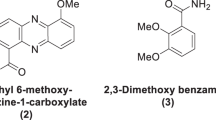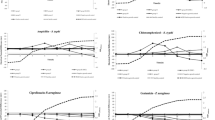Abstract
In consideration of high production costs of new antimicrobial drugs, a more convenient and economical method for time–kill study is urgently required. In the present experiment, we attempted to demonstrate the feasibility of microplate method as an alternative measure of macrodilution method for time–kill study. Three conventional antibiotics (ciprofloxacin, ceftazidime, and levofloxacin) and two antimicrobial peptides [A-thanatin and K4-S4(1–16)a] were used to determine time–kill curves against Escherichia coli ATCC 25922 and Staphylococcus epidermidis ATCC 14990. Meanwhile, both methods were also performed with three antisense peptide nucleic acids (PNA3, PNA4, and PNA5) targeting ropD gene of Staphylococcus aureus ATCC 29213 and MRSA WHO-2. In order to study the correlation between the two methods, the growth inhibition rate of PNAs, antimicrobial peptides, and antibiotics for the tested strains were evaluated. A strong agreement between the results obtained from the two methods has been demonstrated. Although microplate method required longer incubation time for a significant result than macrodilution method, the former provides a more convenient, economical, and stable way to perform time–kill test for these agents. Thus, we concluded that microplate method was an available measure for time–kill study of new antimicrobial drugs.



Similar content being viewed by others
References
Andis S (2004) Development of a new PNA analogue as a potential antisense drug an tool for life-science studies. Karolinska University Press, Stokholm
Balaban N, Gov Y, Giacometti A, Cirioni O, Ghiselli R, Mocchegiani F, Orlando F, D’Amato G, Saba V, Scalise G, Bernes S, Mor A (2004) A chimeric peptide composed of a dermaseptin derivative and an RNA III-inhibiting peptide prevents graft-associated infections by antibiotic-resistant staphylococci. Antimicrob Agents Chemother 48:2544–2550
Geller BL, Deere J, Tilley L, Iversen PL (2005) Antisense phosphorodiamidate morpholino oligomer inhibits viability of Escherichia coli in pure culture and in mouse peritonitis. J Antimicrob Chemother 55:983–988
Gupta P, Zengeya T, Rozners E (2011) Triple helical recognition of pyrimidine inversions in polypurine tracts of RNA by nucleobase-modified PNA. Chem Commun (Camb) 47:11125–11127
Hancock RE, Sahl HG (2006) Antimicrobial and host-defense peptides as new anti-infective therapeutic strategies. Nat Biotechnol 24:1551–1557
Hatamoto M, Ohashi A, Imachi H (2010) Peptide nucleic acids (PNAs) antisense effect tobacterial growth and their application potentiality in biotechnology. Appl MicrobiolBiotechnol 86:397–402
Hou Z, Meng J, Niu C, Wang H, Liu J, Hu B, Jia M, Luo X (2007) Restoration of antibiotic susceptibility in methicillin-resistant Staphylococcus aureus by targeting mecR1 with a phosphorothioate deoxyribozyme. Clin Exp Pharmacol Physiol 34:1160–1164
Hou Z, Lu J, Fang C, Zhou Y, Bai H, Zhang X, Xue X, Chen Y, Luo X (2011) Underlying mechanism of in vivo and in vitro activity of C-terminal-amidated thanatin against clinical isolates of extended-spectrum β-lactamase-producing Escherichia coli. J Infect Dis 203:273–282
Hunter HN, Fulton DB, Ganz T, Vogel HJ (2002) The solution structure of human hepcidin, a peptide hormone with antimicrobial activity that is involved in iron uptake and hereditary hemochromatosis. J Biol Chem 277:37597–37603
Klepser ME, Ernst EJ, Lewis RE, Ernst ME, Pfaller MA (1998) Influence of test conditions on antifungal time–kill curve results: proposal for standardized methods. Antimicrob Agents Chemother 42:1207–1212
Kollef MH (2009) New antimicrobial agents for methicillin-resistant Staphylococcus aureus. Crit Care Resusc 11:282–286
Li Y, Sun SJ, Guo QJ, Ma L, Shi CW, Su LQ, Li HJ (2008) In vitro interaction between azoles and cyclosporin A against clinical isolates of Candida albicans determined by the chequerboard method and time–kill curves. J Antimicrob Chemother 61:577–585
Marr AK, Gooderham WJ, Hancock RE (2006) Antibacterial peptides for therapeutic use: obstacles and realistic outlook. Curr Opin Pharmacol 6:468–472
Meng JR, Wang H, Hou Z, Chen T, Fu JG, Ma X, He GH, Xue XY, Jia M, Luo XX (2009) The novel anion liposome encapsulated antisense oligonucleotide restores susceptibility of MRSA and rescues mice from lethal sepsis by targeting mecA. Antimicrob Agents Chemother 53:2871–2878
Naghmouchi K, Drider D, Hammami R, Fliss I (2008) Effect of antimicrobial peptides divergicin M35 and nisin A on Listeria monocytogenes LSD530 potassium channels. Curr Microbiol 56:609–612
Navon-Venezia S, Feder R, Gaidukov L, Cirioni O, Ghiselli R, Mocchegiani F, Orlando F, D’Amato G, Saba V, Scalise G, Bernes S, Mor A (2002) Antibacterial properties of dermaseptin S4 derivatives with in vivo activity. Antimicrob Agents Chemother 46:689–694
Nielsen EI, Viberg A, Löwdin E, Cars O, Karlsson MO, Sandström M (2007) Semimechanistic pharmacokinetic/pharmacodynamic model for assessment of activity of antibacterial agents from time–kill curve experiments. Antimicrob Agents Chemother 51:128–136
Nikravesh A, Dryselius R, Faridani OR, Goh S, Sadeghizadeh M, Behmanesh M, Ganyu A, Klok EJ, Zain R, Good L (2007) Antisense PNA accumulates in Escherichia coli and mediates a long post-antibiotic effect. Mol Ther 15:1537–1542
Oyston PC, Fox MA, Richards SJ, Clark GC (2009) Novel peptide therapeutics for treatment of infections. J Med Microbiol 58:977–987
Rasmussen LC, Sperling-Petersen HU, Mortensen KK (2007) Hitting bacteria at the heart of the central dogma: sequence-specific inhibition. Microb Cell Fact 6:24
Schiavone N, Donnini M, Nicolin A, Capaccioli S (2004) Antisense oligonucleotide drug design. Curr Pharm Des 10:769–784
Singh SB, Phillips JW, Wang J (2007) Highly sensitive target-based whole-cell antibacterial discovery strategy by antisense RNA silencing. Curr Opin Drug Discov Devel 10:160–166
Sivaprakasam S, Mahadevan S, Rajakumar S (2008) Biocalorimetric studies of the metabolic activity of Pseudomonas aeruginosa aerobically grown in a glucose-limited complex growth medium. Biosci Biotechnol Biochem 72:936–942
Stratton CW, Weeks LS, Aldridge KE (1987) Comparison of kill-kinetic studies with agar and broth microdilution methods for determination of antimicrobial activity of selected agents against members of the Bacteroides fragilis group. J Clin Microbiol 25:645–649
Tan XX, Actor JK, Chen Y (2005) Peptide nucleic acid antisense oligomer as a therapeutic strategy against bacterial infection: proof of principle using mouse intraperitoneal infection. Antimicrob Agents Chemother 49:3203–3207
Wright GD (2009) Making sense of antisense in antibiotic drug discovery. Cell Host Microbe 6:197–198
Wu G, Ding J, Li H, Li L, Zhao R, Shen Z, Fan X, ** T (2008) Effects of cations and pH on antimicrobial activity of thanatin and s-thanatin against Escherichia coli ATCC25922 and B. subtilis ATCC 21332. Curr Microbiol 57:552–557
Acknowledgments
We thank the help from **uli Xu (****g Hospital, Shaanxi, China) for quality control strains. This work was supported by grants from the National Natural Science foundation of China (no. 81001460) and special funding doctoral dissertation of Fourth Military Medical University (no. 2007D15).
Author information
Authors and Affiliations
Corresponding author
Additional information
Ying Zhou and Zheng Hou contributed equally to this study.
Rights and permissions
About this article
Cite this article
Zhou, Y., Hou, Z., Fang, C. et al. Comparison of microplate and macrodilution methods in time–kill study of new antimicrobial drugs. Folia Microbiol 58, 9–16 (2013). https://doi.org/10.1007/s12223-012-0168-8
Received:
Accepted:
Published:
Issue Date:
DOI: https://doi.org/10.1007/s12223-012-0168-8




